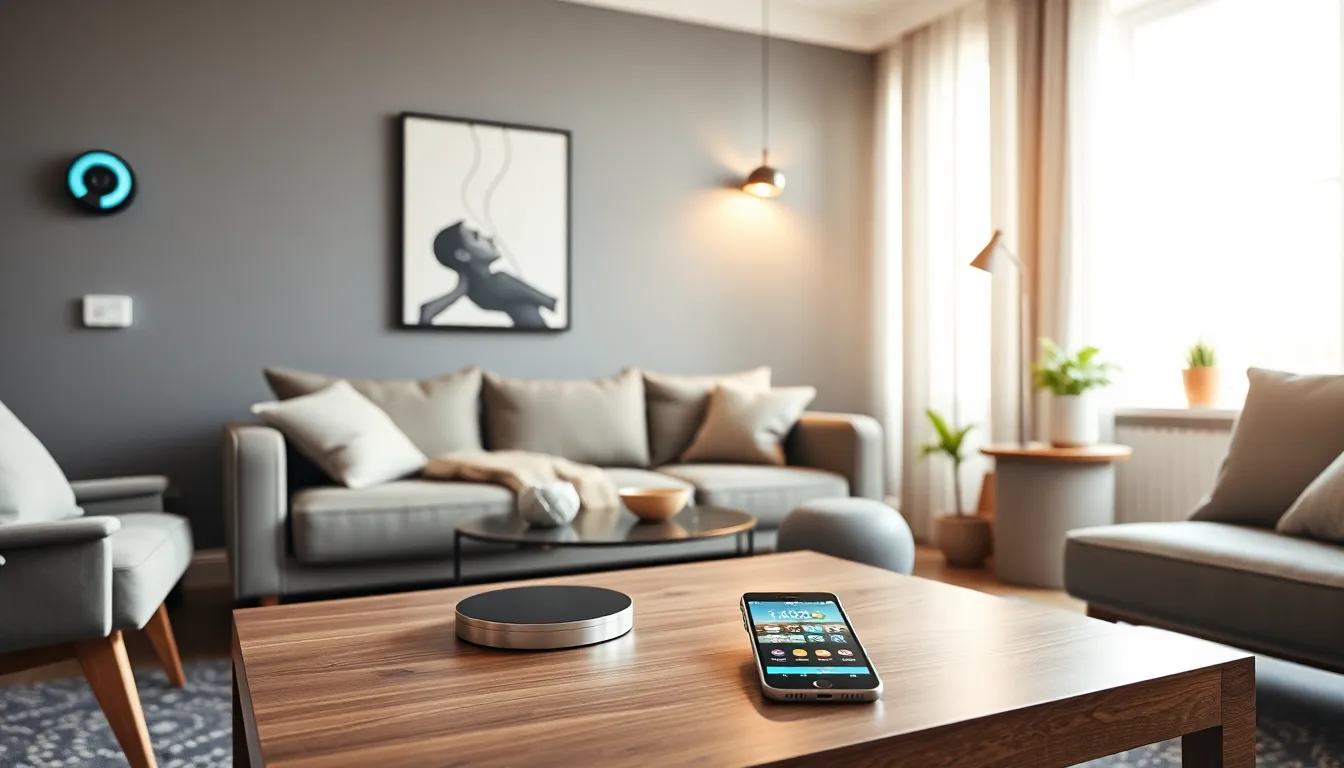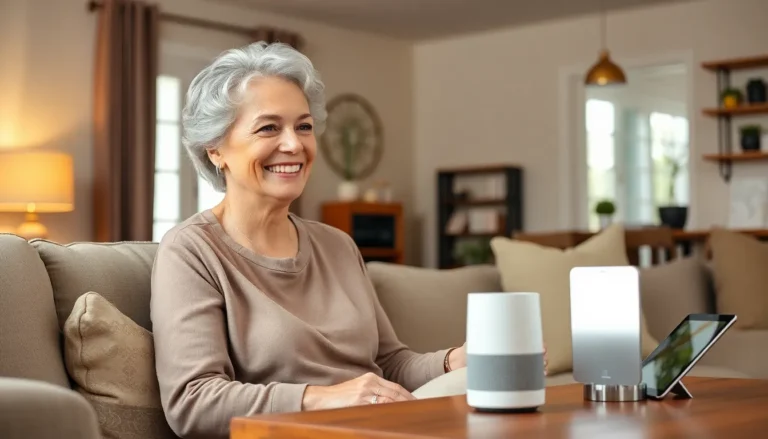Table of Contents
ToggleIn today’s fast-paced world, smart home systems are revolutionizing the way people interact with their living spaces. These innovative technologies seamlessly integrate various devices, allowing homeowners to control everything from lighting to security with just a few taps on their smartphones. As convenience becomes a priority, more individuals are embracing smart home solutions to enhance their daily lives.
Imagine walking into a home that adjusts the temperature, dims the lights, and plays your favorite music all at once. This level of automation not only simplifies routines but also promotes energy efficiency and security. With advancements in artificial intelligence and IoT, smart home systems are becoming more accessible and user-friendly, making them a compelling choice for anyone looking to modernize their home.
Overview Of Smart Home Systems
Smart home systems integrate various technologies to enhance the control and automation of home environments. They leverage connectivity and intelligence, improving convenience, security, and energy efficiency.
Definition And Purpose
Smart home systems consist of interconnected devices that enable remote management and monitoring of home functions. These systems aim to simplify everyday tasks and increase the safety of living environments. Homeowners control systems like lighting, heating, and security remotely through smartphones or voice-activated assistants. By providing real-time data, smart home systems empower users to make informed decisions and optimize their home environments.
Key Features
- Automation: Smart home devices automate routine tasks, such as turning lights on and off or adjusting thermostats based on user preferences.
- Remote Control: Users can manage home systems from anywhere via mobile apps, providing flexibility and real-time monitoring.
- Security: Smart security devices, like cameras and alarms, enhance home safety with instant alerts and video feeds accessible on mobile devices.
- Energy Management: Smart appliances and sensors monitor energy usage, promoting efficiency and reducing utility bills.
- Integration: Multiple devices work together seamlessly, allowing for customized experiences and streamlined control across various platforms.
Benefits Of Smart Home Systems

Smart home systems provide significant advantages that improve the overall living experience. They enhance security, promote energy efficiency, and offer unmatched convenience and comfort.
Enhanced Security
Enhanced security remains a notable benefit of smart home systems. Smart devices, such as cameras and alarms, allow homeowners to monitor their property remotely. Notifications alert users to unusual activity, enabling prompt responses. Features like smart locks provide keyless entry and remote access management. Integration with local law enforcement enhances emergency response options, ensuring greater peace of mind.
Energy Efficiency
Energy efficiency becomes easier with smart home systems. Smart thermostats optimize heating and cooling schedules based on user habits, reducing energy consumption by 10-15%. Automated lighting systems turn off lights in unoccupied rooms, further lowering utility costs. Energy monitoring devices track usage patterns, enabling informed adjustments to promote sustainability. These systems also support eco-friendly practices by reducing the carbon footprint of homes.
Convenience And Comfort
Convenience and comfort stand out in smart home systems. Homeowners control appliances and systems through smartphone apps, making daily tasks simpler. Voice-activated assistants allow for hands-free operation of devices, enhancing accessibility. Routine automation, such as turning on the coffee maker at a scheduled time, adds ease to daily life. This seamless integration of technology creates a more enjoyable and personalized living environment.
Popular Smart Home Devices
Smart home devices enhance automation and convenience in daily living. Several key devices play crucial roles in transforming these everyday environments.
Smart Speakers
Smart speakers function as central control hubs for smart home systems. They allow users to issue voice commands to control devices, play music, set reminders, and access information. Popular brands, such as Amazon Echo and Google Nest, utilize virtual assistants like Alexa and Google Assistant. Integration with other smart devices enables seamless communication between appliances. Additionally, smart speakers can support routines that automate multiple actions with a single command.
Smart Thermostats
Smart thermostats optimize energy usage by learning homeowners’ preferences and schedules. Devices like the Nest Learning Thermostat and Ecobee SmartThermostat adapt the heating and cooling temperatures accordingly. Users can manage these devices remotely through mobile apps, making it easier to adjust settings while away from home. Enhanced features, such as geofencing and energy reports, promote efficiency and help reduce utility costs, contributing to a more sustainable household.
Smart Security Cameras
Smart security cameras improve home security by providing real-time monitoring and alerts. Brands like Ring and Arlo offer outdoor and indoor options with high-definition video and night vision capabilities. Homeowners can access live feeds and recorded footage through mobile apps, enhancing peace of mind. Features such as motion detection, two-way audio, and cloud storage further strengthen security. Remote management allows prompt responses to unusual activities, ensuring safety at all times.
Considerations When Choosing A Smart Home System
Selecting a smart home system involves assessing various factors that impact functionality and user experience. Homeowners must prioritize compatibility, ease of use, and financial implications when making a decision.
Compatibility With Existing Devices
Ensuring compatibility with existing devices plays a crucial role in choosing a smart home system. Homeowners should confirm that new devices integrate seamlessly with current technology, including lighting, heating, and security systems. Popular platforms, such as Amazon Alexa or Google Assistant, often provide extensive compatibility with various brands. Assessing compatibility prevents the need for additional hardware and promotes a cohesive smart home environment.
User-Friendly Interfaces
User-friendly interfaces enhance the overall experience of a smart home system. Homeowners benefit from intuitive mobile apps and voice command features. Well-designed interfaces require minimal setup and allow for easy adjustments and automation of devices. Users should prioritize systems that provide clear instructions and robust support to simplify the transition to smart technology, making daily interactions smooth and efficient.
Cost And Installation
Cost and installation are significant factors in the decision-making process. Homeowners need to consider upfront expenses, ongoing fees, and potential savings from energy efficiency. Installation options vary; some systems offer DIY installation, while others may require professional assistance. Evaluating costs alongside long-term savings helps in determining the best value for a smart home system.
Future Trends In Smart Home Technology
Future trends in smart home technology point toward increased integration, enhanced AI capabilities, and improved user experiences. Emerging developments within the industry include:
- Artificial Intelligence Enhancements: AI advancements enable devices to learn user behaviors and preferences, leading to personalized automation. Systems become more intuitive, anticipating needs before users express them.
- Interoperability Across Devices: New protocols, such as Matter, promote seamless integration among different brands and devices. Homeowners benefit from easier communications between products, enhancing the overall user experience.
- Increased Focus on Energy Efficiency: Technologies prioritize eco-friendly solutions, incorporating renewable energy sources and intelligent energy management. Smart devices reduce energy consumption and help homeowners track usage patterns for better efficiency.
- Expanding Role of Voice Assistants: Voice-controlled devices expand functionalities, allowing users to manage systems hands-free. Smart assistants become central to interactions, enhancing accessibility for various demographics.
- Enhanced Security Features: Innovations in security technology improve monitoring capabilities with advanced facial recognition and real-time threat detection. Homeowners gain peace of mind with smarter responses to security breaches.
- Integration with Wearable Technology: Smart home systems increasingly connect with wearables, enabling users to control home environments through their devices. This connectivity enhances convenience and personalizes the smart home experience.
- Growing Adoption of Health Monitoring: Smart home systems incorporate health-oriented features, such as air quality monitoring and environmental sensors. These developments create safer environments while promoting overall wellness for residents.
- 5G Connectivity: The rollout of 5G networks enhances smart home capabilities through faster and more reliable connections. This speed facilitates real-time data processing and communication between devices.
These trends collectively signify a shift towards more sophisticated, user-friendly, and efficient smart home technologies, shaping the future of home automation.
Smart home systems are revolutionizing the way people interact with their living spaces. By integrating advanced technologies homeowners can enjoy improved convenience security and energy efficiency. As these systems continue to evolve they promise even greater accessibility and customization.
The future of smart home technology looks bright with innovations in AI and IoT paving the way for more intuitive user experiences. Homeowners can expect seamless integration of devices enhanced automation and smarter energy management solutions. With the right smart home system individuals not only enhance their quality of life but also contribute to a more sustainable future. Embracing these advancements can lead to a more connected and efficient home environment.




